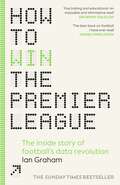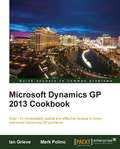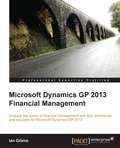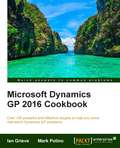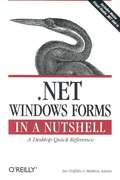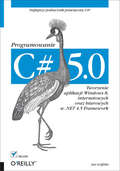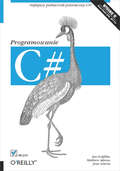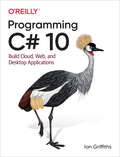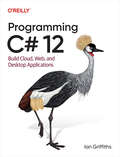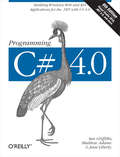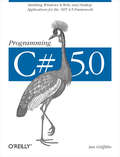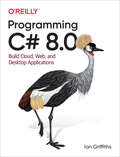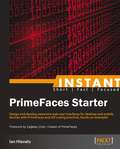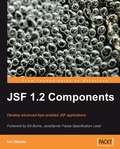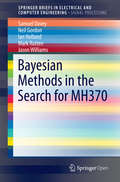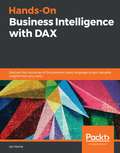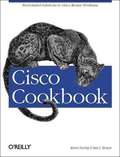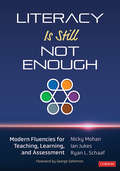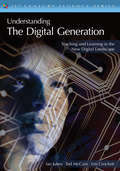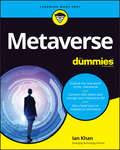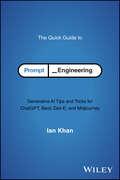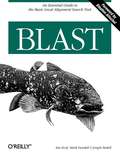- Table View
- List View
How to Win the Premier League: The Sunday Times Bestselling Inside Story of Football's Data Revolution
by Ian GrahamTHE SUNDAY TIMES BESTSELLER'The best book on football I have ever read' Daniel Finkelstein'Fascinating and educational. An enjoyable and informative read' Sir Kenny Dalglish'Deserves a place among the great modern books on football' Sam Wallace, chief football writer, Telegraph______________________________The insider account of the data revolution that has swept through the modern football world written by one of its key architects, Ian Graham.Between 2012 and 2023, Ian Graham worked as Liverpool FC's Director of Research. His tenure coincided with the club’s greatest period of success since the 1980s, including winning the Premier League in 2020 – Liverpool’s first league title after an agonising three decades.Here for the first time, Graham reveals the fascinating data that informed some of the club’s most pivotal moments of the past decade, from the appointment of Jurgen Klopp as manager in 2015 to the signing of Mohamed Salah in 2017. Along the way, he shares groundbreaking insight into the modern game, including how a season largely played behind closed doors transformed our understanding of home team advantage, or why the GOAT (greatest of all time) might not be who you think. And, in a game that is increasingly dominated by an elite few, Graham charts a path for the future where a data-savvy competitor will always find the edge.______________________________'A fascinating, witty and remarkably insightful account of Liverpool's reinvention and a clear-eyed, detailed explanation of the inner workings of modern football. Nobody is better qualified to tell either of those stories than Ian Graham, who stands as one of the most (quietly) significant figures in the recent history of the club and the sport' Rory Smith, author of Expected Goals and Chief Soccer Correspondent, New York Times'Never before has the data revolution in football been described so well from the inside.' Christoph Biermann, author of Football Hackers‘How to Win the Premier League gives you three books for the price of one: a book about all of the silly inefficiencies plaguing European football, a book about what it's like to be empowered to use outside-the-box thinking to help turn your boyhood club into the best team in the world, and a book about how football actually works. If he really wanted to, Ian could easily put me out of a job.’Ryan O’Hanlon, author of Net Gains and staff writer ESPN*A Sunday Times bestseller August 2024
Microsoft Dynamics GP 2013 Cookbook
by Ian Grieve Mark PolinoMicrosoft Dynamics GP 2013 Cookbook is a highly practical beginner to intermediate Cookbook to improve your efficiency and master your use of Microsoft Dynamics GP 2013. All the recipes are time-proven; real-world tested, and designed to be used immediately.If you're a Dynamics GP partner or Dynamics GP user, primarily focused on delivering application optimizations, then "Microsoft Dynamics GP 2013 Cookbook" is for you.This book assumes that you have a basic knowledge of Microsoft Dynamics GP, a basic understanding of business management systems, and some exposure to Microsoft SQL Server.
Microsoft Dynamics GP 2013 Financial Management
by Ian GrieveA standard tutorial-based approach covering Microsoft Dynamics GP 2013 and its six financial modules. The book is intended to allow users to improve their system use and workflow by introducing new modules to assist in financial management.This book is for you if you're a Dynamics GP partner, or Dynamics GP user, primarily focused on delivering application optimizations. This book assumes that you have a working knowledge of Microsoft Dynamics GP and have an understanding of the requirements of financial management.
Microsoft Dynamics GP 2016 Cookbook - Second Edition
by Ian Grieve Mark PolinoThe book is for Dynamics GP users or Dynamics GP partners. It assumes that you have a basic understanding of business management systems and Microsoft Dynamics GP.
.NET Windows Forms in a Nutshell
by Matthew Adams Ian Griffiths.NET Windows Forms are a powerful technology for building a large class of applications for the Windows .NET platform. They offer nearly the same power and flexibility of classic Win32 development, but for a fraction of the effort. The programming model is lean and streamlined, and many of the tedious details that developers used to have to spend time on are now dealt with automatically by the platform. .NET Windows Forms in a Nutshell offers an accelerated introduction to this next-generation of rich user interface development. The book provides an all-inclusive guide for experienced programmers using the .NET Windows Forms platform to develop Windows applications, along with a compact but remarkably complete reference to the .NET Framework Class Library (FCL) Windows Forms namespaces and types. The authors present solid coverage of the fundamental building blocks, such as Controls, Forms, Menus, and GDI+, and enough detail to help you build your own fully featured reusable visual components so you can write visual component libraries as well as standalone applications. .NET Windows Forms in a Nutshell aims to provide not just the practical information and advice required to get programs working, but also to communicate the rationale behind the various parts of Windows Forms' design. The authors show how the thinking behind the framework enhances your productivity substantially. The new framework allows you to guess correctly what "the Right Way" to do things is a majority of the time, even if you've never tried what you're doing before. No more digging around in documentation for days to try to find the bit of information you need to use one particular feature. Anyone who is involved in user interface development will appreciate the ease of creation and expanded capabilities provided by .NET Windows Forms, as well as the in-depth focus and straight-forward approach this book brings. Included on CD is an add-in that will integrate the book's reference directly into the help files of Visual Studio .NET.
C# 5.0. Programowanie. Tworzenie aplikacji Windows 8, internetowych oraz biurowych w .NET 4.5 Framework
by Ian GriffithsNajlepszy podr?cznik po?wi?cony C#! W dzisiejszych czasach szczególn? popularno?ci? ciesz? si? j?zyki programowania pozwalaj?ce na pisanie kodu ?atwego do przenoszenia mi?dzy platformami. Nikt nie ma czasu na pisanie kilku wersji jednej aplikacji. C# to uniwersalny j?zyk, w którym bez trudu dokonasz tego dzie?a. Dzi?ki swej elastyczno?ci, wydajno?ci oraz mocnemu wsparciu spo?eczno?ci zdoby? on uznanie programistów. Taki wybór to strza? w dziesi?tk?!Ten rewelacyjny podr?cznik jest Twoim kluczem do poznania wszystkich niuansów j?zyka C# 5.0. Kolejne wydanie zosta?o zaktualizowane o wszystkie nowo?ci w C#. Znajdziesz tu kompletny opis j?zyka i platformy .NET. W trakcie lektury oprócz standardowych zagadnie? b?dziesz móg? sprawdzi?, jak tworzy? aplikacje dla systemu Windows 8 i interfejsu Metro. Ponadto b?yskawicznie opanujesz detale zwi?zane z programowaniem obiektowym, dynamicznym i statycznym okre?laniem typów oraz j?zykiem XAML. Ksi??ka ta jest uznanym kompendium wiedzy na temat j?zyka C#. Musisz j? mie?!Dzi?ki tej ksi??ce:przygotujesz interfejs u?ytkownika zgodny z duchem Windows 8wykorzystasz wielow?tkowo?? w platformie .NETpoznasz podstawy programowania obiektowegoprzekonasz si?, jak LINQ mo?e u?atwi? Ci ?ycieopanujesz j?zyk C#Wykorzystaj potencja? j?zyka C#! Ian Griffiths jest autorem kursu WPF oraz instruktorem w firmie Pluralsight, specjalizuj?cej si? w prowadzeniu kursów Microsoft .NET. Pracuje tak?e jako niezale?ny konsultant. Jest wspó?autorem ksi??ek „Windows Forms in a Nutshell”, „Mastering Visual Studio .NET” oraz „Programming WPF”, wydanych przez wydawnictwo O’Reilly.
C#. Programowanie. Wydanie VI
by Matthew Adams Jesse Liberty Ian GriffithsNajlepszy podr?cznik po?wi?cony C#!W dzisiejszych czasach szczególnš popularno?ciš cieszš si? j?zyki programowania pozwalajšce na pisanie kodu ?atwego do przenoszenia mi?dzy platformami, poniewa? nikt nie ma czasu na pisanie kilku wersji jednej aplikacji. C# to uniwersalny j?zyk, który bez trudu spe?nia ten wymóg. Dzi?ki swej elastyczno?ci, wydajno?ci oraz mocnemu wsparciu spo?eczno?ci zdoby? on uznanie programistów. Jego wybór to strza? w dziesištk?!Ten bestsellerowy podr?cznik pozwoli Ci b?yskawicznie pozna? wszystkie niuanse j?zyka C# 4.0. Najnowsze wydanie zosta?o zaktualizowane o nowo?ci w C# oraz zawiera opis tego j?zyka i platformy .NET. W trakcie lektury nauczysz si? tworzy? skomplikowane programy przy u?yciu technik programowania obiektowego i funkcjonalnego. Ponadto sprawdzisz, jaki potencja? kryje j?zyk zapyta? LINQ oraz jak przesy?a? komunikaty za pomocš Windows Communication Foundation (WCF). Dodatkowo poznasz mo?liwo?ci C# w zakresie tworzenia aplikacji internetowych w technologii Silverlight. Nauka C# jeszcze nigdy nie by?a tak przyjemna!Pisz z?o?one programy z u?yciem technik programowania obiektowego oraz funkcjonalnegoPrzetwarzaj du?e kolekcje danych dzi?ki wbudowanym w j?zyk zapytaniom LINQKomunikuj si? przez sie? za pomocš Windows Communication Foundation (WCF)Poznaj zalety technik programowania dynamicznego, dost?pnych w C# 4.0Twórz interaktywne aplikacje Windows z Windows Presentation Foundation (WPF)Twórz bogate aplikacje internetowe z wykorzystaniem mo?liwo?ci Silverlight oraz ASP.NETWykorzystaj potencja? j?zyka C#!Ian Griffiths jest autorem kursu WPF oraz instruktorem w firmie Pluralsight, specjalizujšcej si? w prowadzeniu kursów Microsoft .NET. Pracuje tak?e jako niezale?ny konsultant. Jest wspó?autorem ksiš?ek "Windows Forms in a Nutshell", "Mastering Visual Studio .NET" oraz "Programming WPF", wydanych przez wydawnictwo O"Reilly.Matthew Adams jest kierownikiem do spraw tworzenia aplikacji w firmie Digital Healthcare Ltd. oraz autorem wielu artyku?ów i publikacji dotyczšcych znaczenia .NET w przemy?le informatycznym.Jesse Liberty jest starszym kierownikiem programu Microsoft Silverlight. Jest doskonale znany w ?rodowisku jako jeden z czo?owych ekspertów oraz autor bestsellerowych ksiš?ek, takich jak "Programming C# 3.0" (O"Reilly) oraz "ASP.NET 3.5. Programowanie" i "ASP.NET 2.0 i Ajax".
Programming C# 10: Build Cloud, Web, and Desktop Applications
by Ian GriffithsC# is undeniably one of the most versatile programming languages available to engineers today. With this comprehensive guide, you'll learn just how powerful the combination of C# and .NET can be. Author Ian Griffiths guides you through C# 10.0 and .NET 6 fundamentals and techniques for building cloud, web, and desktop applications.Designed for experienced programmers, this book provides many code examples to help you work with the nuts and bolts of C#, such as generics, LINQ, and asynchronous programming features. You'll get up to speed on .NET 6 and the latest C# 9.0 and 10.0 additions, including records, enhanced pattern matching, and new features designed to remove "ceremony" to improve productivity.Understand how .NET has changed in the most recent releases, and learn what it means for application developmentSelect the most appropriate C# language features for any taskLearn when to use the new features and when to stick with older onesExamine the range of functionality available in .NET's class librariesLearn how you can apply these class libraries to practical programming tasksExplore numerous small additions to .NET that improve expressiveness"Unlike books that focus on Visual Studio and technologies that interact with C#, this one covers the core language, and mastery of this core is essential to successfully building good software. It covers important concepts followed by generous code examples to explain them. It's thorough, detailed, and gets at the nooks and crannies of the language rarely covered elsewhere. It's a complete course on C#."--Jeremy MorganSoftware/DevOps EngineerIan Griffiths has worked in various aspects of computing, including computer networking, embedded real-time systems, broadcast television systems, medical imaging, and all forms of cloud computing. Ian is a Technical Fellow at endjin, and a Microsoft MVP in Developer Technologies. He's the author of several O'Reilly books and has written courses on Windows Presentation Foundation (WPF) and TPL Tables. Technology brings him joy.
Programming C# 12: Build Cloud, Web, and Desktop Applications
by Ian GriffithsC# is undeniably one of the most versatile programming languages available to engineers today. With this comprehensive guide, you'll learn just how powerful the combination of C# and .NET can be. Author Ian Griffiths guides you through C# 12.0 and .NET 8 fundamentals and techniques for building cloud, web, and desktop applications.Designed for experienced programmers, this book provides many code examples to help you work with the nuts and bolts of C#, such as generics, LINQ, and asynchronous programming features. You'll get up to speed on .NET 8 and the latest C# 11.0 and 12.0 additions, including generic math, new polymorphism options, enhanced pattern matching, and new features designed to improve productivity.This book helps you:Understand how .NET has changed in recent releases and learn what it means for application developmentSelect the appropriate C# language features for any taskLearn when to use the new features and when to stick with older onesExamine the range of functionality in .NET's class librariesApply these class libraries to practical programming tasksExplore numerous small additions to .NET that improve expressiveness
Programming C# 4.0: Building Windows, Web, and RIA Applications for the .NET 4.0 Framework (Animal Guide)
by Matthew Adams Jesse Liberty Ian GriffithsWith its support for dynamic programming, C# 4.0 continues to evolve as a versatile language on its own. But when C# is used with .NET Framework 4, the combination is incredibly powerful. This bestselling tutorial shows you how to build web, desktop, and rich Internet applications using C# 4.0 with .NET's database capabilities, UI framework (WPF), extensive communication services (WCF), and more.In this sixth edition, .NET experts Ian Griffiths, Matthew Adams, and Jesse Liberty cover the latest enhancements to C#, as well as the fundamentals of both the language and framework. You'll learn concurrent programming with C# 4.0, and how to use .NET tools such as the Entity Framework for easier data access, and the Silverlight platform for browser-based RIA development.Learn C# fundamentals, such as variables, flow control, loops, and methodsBuild complex programs with object-oriented and functional programming techniquesProcess large collections of data with the native query features in LINQCommunicate across networks with Windows Communication Foundation (WCF)Learn the advantages of C# 4.0's dynamic language featuresBuild interactive Windows applications with Windows Presentation Foundation (WPF)Create rich web applications with Silverlight and ASP.NET
Programming C# 5.0: Building Windows 8, Web, and Desktop Applications for the .NET 4.5 Framework
by Ian Griffiths<p>C# has become one of the most versatile programming languages available. With this comprehensive guide, you’ll learn just how powerful the combination of C# 5.0 and .NET 4.5 can be. Author Ian Griffiths guides you through C# 5.0 fundamentals and teaches you techniques for building web and desktop applications, including Windows 8-style apps.</p>
Programming C# 8.0: Build Cloud, Web, and Desktop Applications
by Ian GriffithsC# is undeniably one of the most versatile programming languages available to engineers today. With this comprehensive guide, you’ll learn just how powerful the combination of C# and .NET can be. Author Ian Griffiths guides you through C# 8.0 fundamentals and techniques for building cloud, web, and desktop applications.Designed for experienced programmers, this book provides many code examples to help you work with the nuts and bolts of C#, such as generics, LINQ, and asynchronous programming features. You’ll get up to speed on .NET Core and the latest C# 8.0 additions, including asynchronous streams, nullable references, pattern matching, default interface implementation, ranges and new indexing syntax, and changes in the .NET tool chain.Discover how C# supports fundamental coding features, such as classes, other custom types, collections, and error handlingLearn how to write high-performance memory-efficient code with .NET Core’s Span and Memory typesQuery and process diverse data sources, such as in-memory object models, databases, data streams, and XML documents with LINQUse .NET’s multithreading features to exploit your computer’s parallel processing capabilitiesLearn how asynchronous language features can help improve application responsiveness and scalability
Instant PrimeFaces Starter
by Ian HlavatsGet to grips with a new technology, understand what it is and what it can do for you, and then get to work with the most important features and tasks. Instant Primefaces Starter is a fast-paced, introductory guide designed to give you all the information you need to start using Primfaces, instantly.Instant PrimeFaces Starter is great for developers looking to get started quickly with PrimeFaces. It's assumed that you have some JSF experience already, as well as familiarity with other Java technologies such as CDI and JPA and an understanding of MVC principles, object-relational mapping (ORM), and dependency injection (DI). The sample application included with the book is fully functional and demonstrates how to use these technologies together with PrimeFaces.
JSF 1.2 Components
by Ian HlavatsThis book is a practical, hands-on guide to learning JavaServer Faces components based on a fictitious computer hardware e-commerce application. It adopts an example-driven approach focused on solving common web application development tasks using a wide range of JSF components from today's most popular JSF component libraries. Each chapter covers a different JSF component library and includes dozens of examples complete with Java source code listings, JSF markup, screenshots, and developer tips. If you are a professional web application developer interested in learning JavaServer Faces having an intermediate to advanced level of Java programming experience and a good understanding of HTML, CSS, and JavaScript, this book is for you. A working knowledge of Java classes, interfaces, annotations, and generics, Java Collections Framework, JavaBeans API, Java Database Connectivity (JDBC), Java Servlets/JSP, Java Authentication and Authorization Service (JAAS), Java Persistence API (JPA), Enterprise JavaBeans (EJB), the Apache Tomcat web container, the JBoss AS 4.2 application server is assumed. Experienced JSF professionals will also find this book useful as a quick reference and "how to" guide.
Bayesian Methods in the Search for MH370 (SpringerBriefs in Electrical and Computer Engineering)
by Neil Gordon Jason Williams Sam Davey Ian Holland Mark RuttenThis book demonstrates how nonlinear/non-Gaussian Bayesian time series estimation methods were used to produce a probability distribution of potential MH370 flight paths. It provides details of how the probabilistic models of aircraft flight dynamics, satellite communication system measurements, environmental effects and radar data were constructed and calibrated. The probability distribution was used to define the search zone in the southern Indian Ocean.The book describes particle-filter based numerical calculation of the aircraft flight-path probability distribution and validates the method using data from several of the involved aircraft’s previous flights. Finally it is shown how the Reunion Island flaperon debris find affects the search probability distribution.
Hands-On Business Intelligence with DAX: Discover the intricacies of this powerful query language to gain valuable insights from your data
by Ian HorneImplement business intelligence (BI), data modeling, and data analytics within Microsoft products such as Power BI, SQL Server, and Excel Key Features Understand the ins and outs of DAX expressions and querying functions with the help of easy-to-follow examples Manipulate data of varying complexity and optimize BI workflows to extract key insights Create, monitor, and improve the performance of models by writing clean and robust DAX queries Book Description Data Analysis Expressions (DAX) is known for its ability to increase efficiency by extracting new information from data that is already present in your model. With this book, you'll learn to use DAX's functionality and flexibility in the BI and data analytics domains. You'll start by learning the basics of DAX, along with understanding the importance of good data models, and how to write efficient DAX formulas by using variables and formatting styles. You'll then explore how DAX queries work with the help of examples. The book will guide you through optimizing the BI workflow by writing powerful DAX queries. Next, you'll learn to manipulate and load data of varying complexity within Microsoft products such as Power BI, SQL Server, and Excel Power Pivot. You'll then discover how to build and extend your data models to gain additional insights, before covering progressive DAX syntax and functions to understand complex relationships in DAX. Later, you'll focus on important DAX functions, specifically those related to tables, date and time, filtering, and statistics. Finally, you'll delve into advanced topics such as how the formula and storage engines work to optimize queries. By the end of this book, you'll have gained hands-on experience in employing DAX to enhance your data models by extracting new information and gaining deeper insights. What you will learn Understand DAX, from the basics through to advanced topics, and learn to build effective data models Write and use DAX functions and expressions with the help of hands-on examples Discover how to handle errors in your DAX code, and avoid unwanted results Load data into a data model using Power BI, Excel Power Pivot, and SSAS Tabular Cover DAX functions such as date, time, and time intelligence using code examples Gain insights into data by using DAX to create new information Understand the DAX VertiPaq engine and how it can help you optimize data models Who this book is for This book is for data analysts, business analysts, BI developers, or SQL users who want to make the best use of DAX in the BI and data analytics domain with the help of examples. Some understanding of BI concepts is mandatory to fully understand the concepts covered in the book.
Cisco Cookbook
by Kevin Dooley Ian J. BrownEverybody who has worked with Cisco routers for any length of time has had to ask their friends and co-workers for example router configuration files that show how to solve a common problem. A good working configuration example can often save huge amounts of time and frustration when implementing a feature that you've never used before. The Cisco Cookbook gathers hundreds of example router configurations all in one place.
Cisco IOS Cookbook
by Kevin Dooley Ian J. BrownNever has something cried out for a cookbook quite as much as Cisco's Internetwork Operating System (IOS). IOS is powerful and flexible, but also confusing and daunting. Most tasks can be accomplished in several different ways. And you don't want to spend precious time figuring out which way is best when you're trying to solve a problem quickly. That's what this cookbook is for. Fortunately, most router configuration tasks can be broken down into several more or less independent steps: you configure an interface, you configure a routing protocol, you set up backup links, you implement packet filters and other access control mechanisms. What you really need is a set of recipes that show you how to perform the most common tasks, so you can quickly come up with a good configuration for your site. And you need to know that these solutions work: you don't want to find yourself implementing a backup link at 2 A.M. because your main link is down and the backup link you set up when you installed the router wasn't quite right. Thoroughly revised and expanded, Cisco IOS Cookbook, 2nd Edition, adds sections on MPLS, Security, IPv6, and IP Mobility, and presents solutions to the most common configuration problems, including: * Configuring interfaces of many types, from serial to ATM and Frame Relay * Configuring all of the common IP routing protocols (RIP, EIGRP, OSPF, and BGP) * Configuring authentication * Configuring other services, including DHCP and NTP * Setting up backup links, and using HSRP to configure backup routers * Managing the router, including SNMP and other solutions * Using access lists to control the traffic through the router If you work with Cisco routers, you need a book like this to help you solve problems quickly and effectively. Even if you're experienced, the solutions and extensive explanations will give you new ideas and insights into router configuration. And if you're not experienced- if you've just been given responsibility for managing a network with Cisco routers- this book could be a job-saver.
Literacy Is Still Not Enough: Modern Fluencies for Teaching, Learning, and Assessment
by Ian Jukes Nicky Mohan Ryan L. SchaafModern fluencies provide a platform for authentic teaching, learning, and assessment While reading, writing, and arithmetic remain important, they are no longer enough. For learners to thrive, they must move beyond traditional literacies to modern fluencies—the unconscious mental processes that are learned, adapted, and applied in the context of real-world problems and challenges. In this book, the authors unpack the fluencies (solution, information, creativity, communication, collaboration, and global citizenship) to reflect the relentless social, cultural, and economic shifts of modern times. Practical resources are presented alongside: Authentic Unit Plan Exemplars for each fluency Assessment rubric examples Discussion questions Learners today must master an entirely different set of essential skills and knowledge needed to succeed than previous generations. This book provides a practical framework for integrating new fluencies into traditional curriculum.
Literacy Is Still Not Enough: Modern Fluencies for Teaching, Learning, and Assessment
by Ian Jukes Nicky Mohan Ryan L. SchaafModern fluencies provide a platform for authentic teaching, learning, and assessment While reading, writing, and arithmetic remain important, they are no longer enough. For learners to thrive, they must move beyond traditional literacies to modern fluencies—the unconscious mental processes that are learned, adapted, and applied in the context of real-world problems and challenges. In this book, the authors unpack the fluencies (solution, information, creativity, communication, collaboration, and global citizenship) to reflect the relentless social, cultural, and economic shifts of modern times. Practical resources are presented alongside: Authentic Unit Plan Exemplars for each fluency Assessment rubric examples Discussion questions Learners today must master an entirely different set of essential skills and knowledge needed to succeed than previous generations. This book provides a practical framework for integrating new fluencies into traditional curriculum.
Understanding the Digital Generation: Teaching and Learning in the New Digital Landscape
by Ian Jukes Lee Crockett Ted McCainAn innovative look at reshaping the educational experiences of 21st-century learners! Inspiring thoughtful discussion that leads to change, this reader-friendly resource examines how the new digital landscape is transforming teaching and learning in an environment of standards, accountability, and high-stakes testing and why informed leadership is so critical. The authors present powerful strategies and compelling viewpoints, underscore the necessity of developing relevant classroom experiences, and discuss: Attributes common among digital learners; The concepts of neuroplasticity and the hyperlinked mind; An educational approach that supports traditional literacy skills alongside 21st-century fluencies; Evaluation methods that encompass how digital generation students process new information.
Metaverse For Dummies
by Ian KhanYour first step to understanding what the metaverse is all about You've probably heard that the metaverse—a word that seemingly went from nonexistent to everywhere — is the next big thing in technology. What is it, anyway? Written by a leading futurist, Metaverse For Dummies unravels the mysteries of the metaverse, for the curious and for anyone looking to get in on the ground floor. Discover how to carve out your niche in the metaverse with easy-to-understand breakdowns of the major technologies and platforms, a guide to doing business in the metaverse, and explorations of what meta means for sports, education, and just about every other area of life. The book even gives you a guide to safety in the metaverse, including how much of your real life you should share in your virtual one. This book answers all the big questions about the metaverse, in simple terms. Explore the metaverse and the major players Get a look at how the metaverse will disrupt industries from gaming to online commerce Discover business opportunities on the metaverse Dive into metaverse gaming and virtual events—safely This book is a must for anyone looking for an approachable primer on what the metaverse is, how it works, and the opportunities within it.
The Quick Guide to Prompt Engineering: Generative AI Tips and Tricks for ChatGPT, Bard, Dall-E, and Midjourney
by Ian KhanDesign and use generative AI prompts that get helpful and practical results In The Quick Guide to Prompt Engineering, renowned technology futurist, management consultant, and AI thought leader Ian Khan delivers a practical and insightful discussion on taking the first steps in understanding and learning how to use generative AI. In this concise and quick start guide, you will learn how to design and use prompts to get the most out of Large Language Model generative AI applications like ChatGPT, DALL-E, Google’s Bard, and more. In the book, you’ll explore how to understand generative artificial intelligence and how to engineer prompts in a wide variety of industry use cases. You’ll also find thoughtful and illuminating case studies and hands-on exercises, as well as step-by-step guides, to get you up to speed on prompt engineering in no time at all. The book has been written for the non-technical user to take the first steps in the world of generative AI. Along with a helpful glossary of common terms, lists of useful additional reading and resources, and other resources, you’ll get: Explanations of the basics of generative artificial intelligence that help you to learn what’s going on under the hood of ChatGPT and other LLMs Stepwise guides to creating effective, efficient, and ethical prompts that help you get the most utility possible from these exciting new tools Strategies for generating text, images, video, voice, music, and other audio from various publicly available artificial intelligence tools Perfect for anyone with an interest in one of the newest and most practical technological advancements recently released to the public, The Quick Guide to Prompt Engineering is a must-read for tech enthusiasts, marketers, content creators, technical professionals, data experts, and anyone else expected to understand and use generative AI at work or at home. No previous experience is required.
BLAST
by Joseph Bedell Ian Korf Mark YandellBLAST (Basic Local Alignment Search Tool) is a set of similarity search programs that explore all of the available sequence databases for protein or DNA. BLAST is the only book completely devoted to this popular and important technology and offers biologists, computational biology students, and bioinformatics professionals a clear understanding of this program. This book shows you how to get specific answers with BLAST and how to use the software to interpret results. If you have an interest in sequence ana
BLAST
by Joseph Bedell Ian Korf Mark YandellSequence similarity is a powerful tool for discovering biological function. Just as the ancient Greeks used comparative anatomy to understand the human body and linguists used the Rosetta stone to decipher Egyptian hieroglyphs, today we can use comparative sequence analysis to understand genomes. BLAST (Basic Local Alignment Search Tool), is a sophisticated software package for rapid searching of nucleotide and protein databases. It is one of the most important software packages used in sequence analysis and bioinformatics. Most users of BLAST, however, seldom move beyond the program's default parameters, and never take advantage of its full power. BLAST is the only book completely devoted to this popular suite of tools. It offers biologists, computational biology students, and bioinformatics professionals a clear understanding of BLAST as well as the science it supports. This book shows you how to move beyond the default parameters, get specific answers using BLAST, and how to interpret your results. The book also contains tutorial and reference sections covering NCBI-BLAST and WU-BLAST, background material to help you understand the statistics behind BLAST, Perl scripts to help you prepare your data and analyze your results, and a wealth of tips and tricks for configuring BLAST to meet your own research needs. Some of the topics covered include: BLAST basics and the NCBI web interface How to select appropriate search parameters BLAST programs: BLASTN, BLASTP, BLASTX, TBLASTN, TBLASTX, PHI-BLAST, and PSI BLAST Detailed BLAST references, including NCBI-BLAST and WU-BLAST Understanding biological sequences Sequence similarity, homology, scoring matrices, scores, and evolution Sequence Alignment Calculating BLAST statistics Industrial-strength BLAST, including developing applications with Perl and BLAST BLAST is the only comprehensive reference with detailed, accurate information on optimizing BLAST searches for high-throughput sequence analysis. This is a book that any biologist should own.
